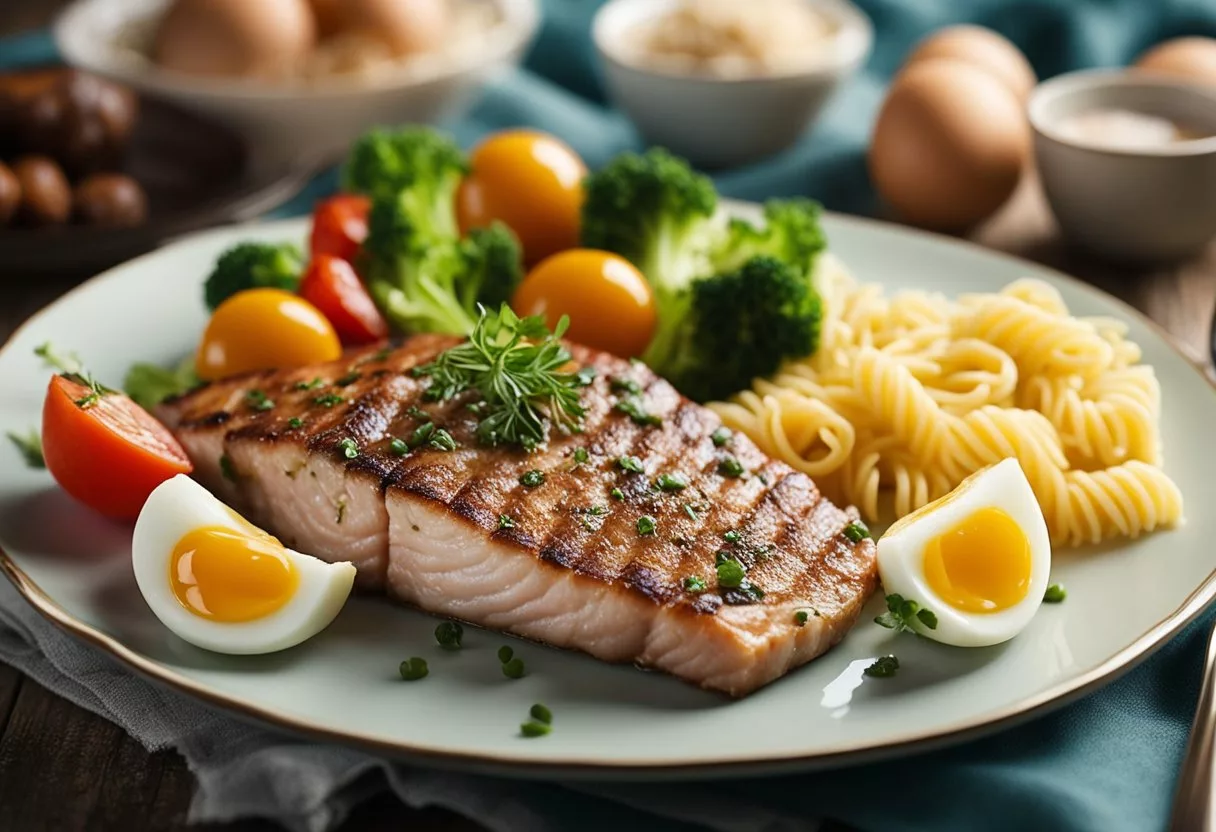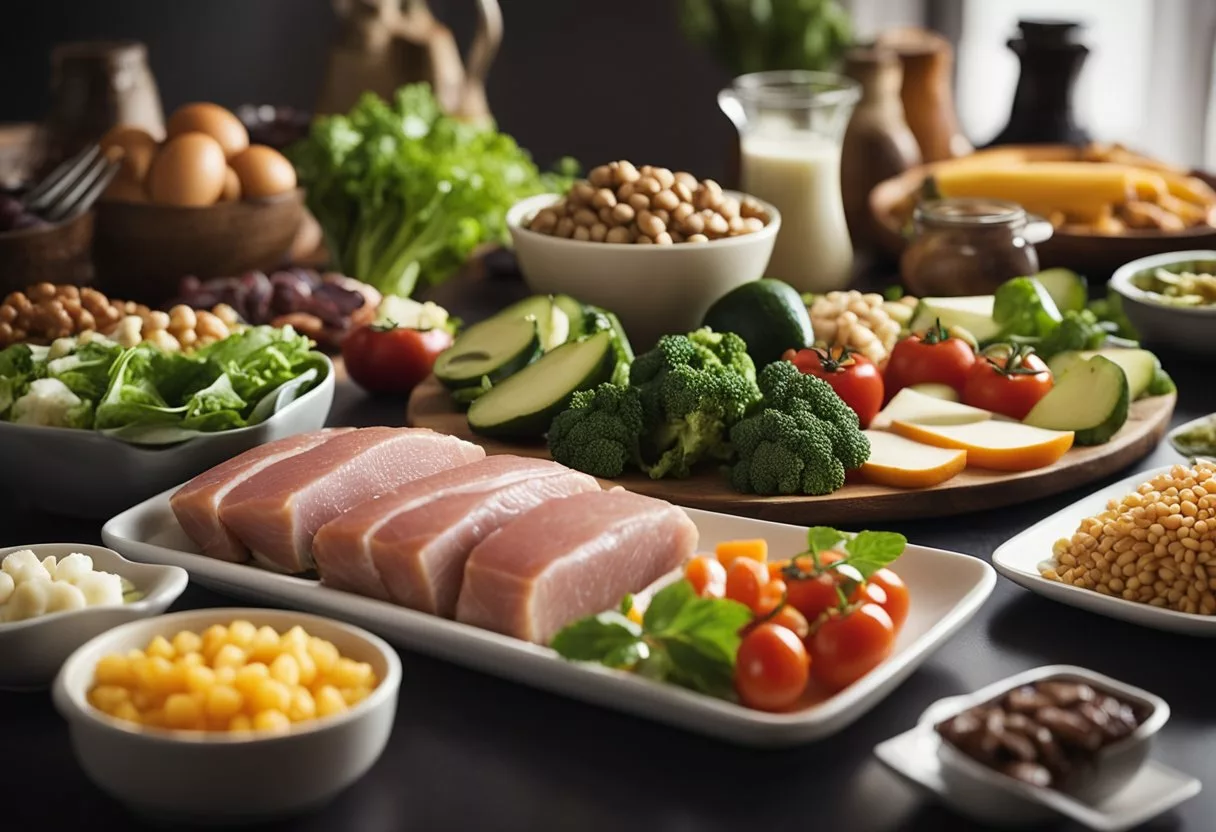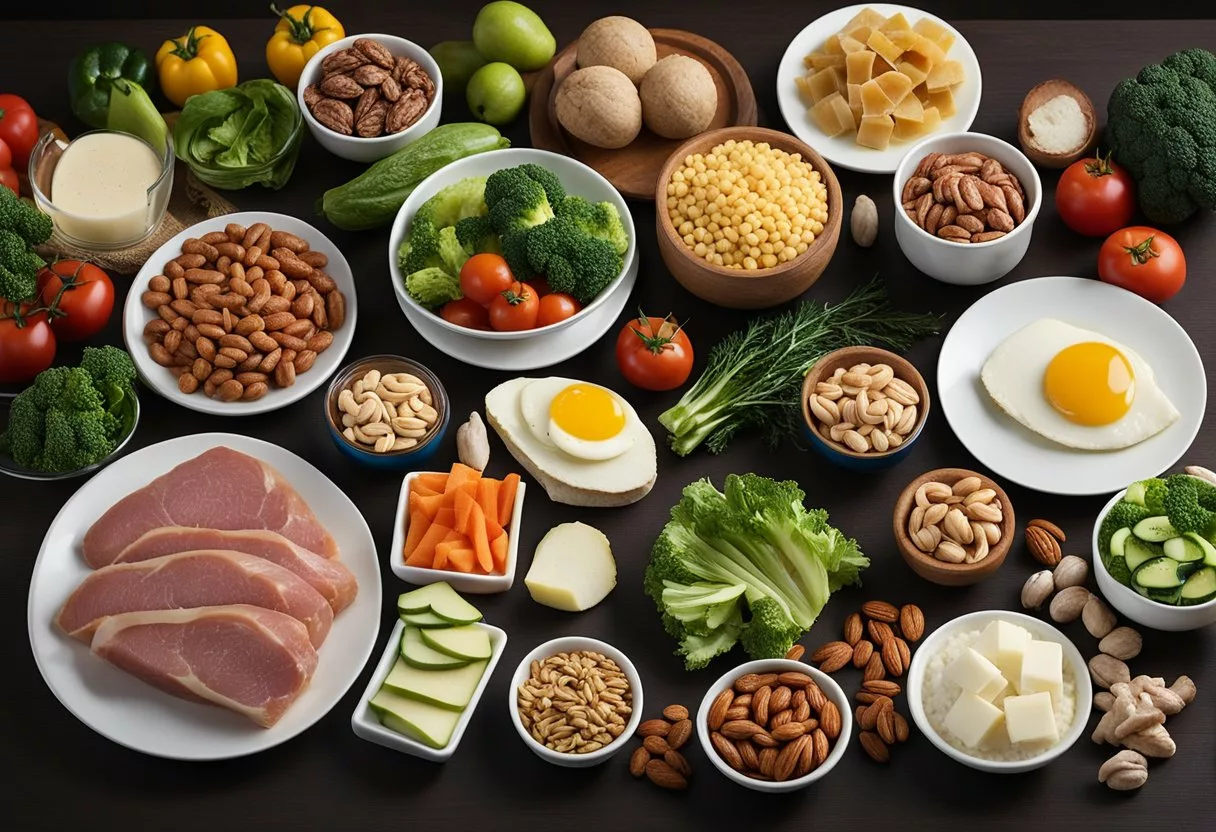The Atkins diet is a popular low-carbohydrate eating plan created by cardiologist Dr. Robert Atkins. Developed to help with weight loss and improve overall health, this diet focuses on reducing carbs and increasing protein and fat intake. This diet is known for its four phases, which gradually increase your carb intake while prioritizing protein and healthy fats.

People often turn to the Atkins diet to shed pounds and boost energy levels. The diet claims to change your metabolism and burn stored body fat for energy, which can lead to noticeable results. It offers various eating styles based on personal goals, allowing people to tailor the plan to their specific needs and preferences.
Many who follow the Atkins diet report improved health markers and successful weight loss. However, it’s important to understand the diet’s structure, including its phases, food choices, and potential risks. To dive deeper into the details of the Atkins diet and see if it’s the right fit for you, keep reading.
Key Takeaways
- Atkins diet is a low-carb eating plan with four phases.
- Focuses on reducing carbs and increasing protein and healthy fats.
- Claims to improve weight loss and boost energy levels.
Basics of the Atkins Diet
The Atkins Diet focuses on low carbohydrate intake while allowing high consumption of protein and fats. It aims to help people lose weight and maintain it through controlled carb consumption.
Defining the Atkins Diet
The Atkins Diet is a popular low-carb eating plan created by cardiologist Robert C. Atkins in the 1960s. This diet restricts carbohydrate intake and emphasizes eating protein and fat. Foods like meat, seafood, eggs, and cheese are highly recommended, while sugars and high-carb foods like bread and pasta are avoided. The central idea is that minimizing carbs helps the body burn fat more efficiently.
Primary Goals and Principles
The main goals of the Atkins Diet are weight loss, weight maintenance, good health, and disease prevention. By reducing carbs, the diet aims to stabilize blood sugar levels and reduce hunger, making it easier to lose weight. Protein and fat become primary sources of energy. This plan promotes the intelligent consumption of carbs, meaning that over time, the type and amount of carbs consumed are carefully managed to maintain weight and health.
Different Phases of the Atkins Diet
The Atkins Diet is divided into four distinct phases:
- Induction: This is the most restrictive phase. Carbs are limited to 20 grams per day, and foods like meat, seafood, eggs, and cheese are encouraged.
- Ongoing Weight Loss (OWL): Gradually introduces more carbs back into the diet while continuing to lose weight. This phase focuses on finding the right level of carb intake.
- Pre-Maintenance: Prepares the individual for lifelong eating habits by allowing more carbs as weight loss goals are nearly achieved.
- Lifetime Maintenance: Focuses on maintaining the target weight while continuing to eat a controlled amount of carbs to prevent weight regain.
Each phase is designed to help the body transition into a low-carb lifestyle and achieve lasting weight control.
Nutritional Aspects

The Atkins diet focuses on reducing carbohydrates while allowing high intake of proteins and healthy fats. It aims to manage weight and boost metabolic health.
Macronutrients Breakdown
The Atkins diet is centered on low carbohydrate consumption. Carbs are restricted to 20-50 grams per day in the initial phase. Protein is deeply emphasized, allowing plenty of meat, eggs, and fish. Fats, especially healthy fats, are encouraged, with sources like avocados, nuts, and olive oil.
A typical daily intake might look like this:
- Carbs: 5-10% of total calories
- Protein: 20-30% of total calories
- Fat: 60-70% of total calories
This focus on macronutrients helps in weight management and reducing cravings.
Fiber and Net Carbs Calculation
Fiber is crucial in the Atkins diet for digestive health. It is not included in the total carbohydrate count. Instead, the Atkins diet uses a net carbs approach, which is total carbs minus fiber content. This method promotes carbs that are less likely to affect blood sugar.
For example, if a food has 10 grams of total carbs and 4 grams of fiber, the net carbs would be 6 grams. This calculation is essential for maintaining the low-carb strategy while ensuring adequate fiber intake.
Sources of fiber in the diet include low-carb vegetables like broccoli, spinach, and cauliflower. The emphasis on net carbs ensures that even with reduced carbohydrate intake, fiber requirements are met.
Expected Health Benefits

The Atkins diet offers numerous health benefits, primarily focusing on weight loss, improved blood sugar levels, and potential heart health improvements.
Weight Loss Outcomes
The Atkins diet is known for its potential to support significant weight loss. By restricting carbohydrates and emphasizing proteins and fats, individuals may experience reduced hunger and calorie intake. This low-carb approach can lead to quick initial weight loss, which is often motivating for those starting the diet. Studies have shown that people on a low-carb diet like Atkins may lose more weight in the first six months compared to those on a low-fat diet. This makes it an attractive option for those looking to shed pounds efficiently.
Blood Sugar and Metabolic Benefits
Another key benefit of the Atkins diet is its positive impact on blood sugar levels and metabolism. The reduction in carbohydrate intake can help stabilize blood sugar, which is particularly beneficial for individuals with type 2 diabetes or insulin resistance. Maintaining stable blood sugar levels can increase energy and reduce the risk of metabolic syndrome. Research indicates that low-carb diets may improve insulin sensitivity and potentially lead to more stable energy levels throughout the day. This makes the Atkins diet a viable option for those managing blood sugar-related health concerns.
Impact on Heart Health
The Atkins diet can also influence heart health. Followers of the diet often experience lower triglycerides and improved cholesterol levels. By reducing carbohydrate intake and incorporating healthy fats, there can be a positive effect on blood pressure and overall heart function. Some studies suggest that the diet may lower the risk of heart disease by improving these markers. However, it is important to note that individual responses can vary, and long-term effects on heart health are still under study. Eating a balanced diet with healthy fats remains critical for heart health.
These examples of improved weight loss outcomes, blood sugar stabilization, and potential heart health benefits highlight the key areas where the Atkins diet can have a positive impact.
Dietary Recommendations

The Atkins diet emphasizes low-carb intake while allowing high-protein and fat consumption. Key factors include what foods to eat, meal planning, and guidelines for alcohol and beverages.
Foods to Eat and Avoid
On the Atkins diet, many foods such as meat, fish, eggs, and cheese are encouraged.
Foods to Eat
- Protein: Meat, fish, eggs, poultry
- Vegetables: Leafy greens, bell peppers, broccoli
- Fats and Oils: Butter, olive oil, coconut oil
- Dairy: Cheese, cream, yogurt
- Nuts and Seeds: Almonds, sunflower seeds
- Fruits: Berries like strawberries, blueberries in moderation
Foods to Avoid
- Carbs: Bread, pasta, rice
- Sugary Foods: Cakes, candies, soda
- Processed Foods: Chips, cookies
- High-Starch Vegetables: Potatoes, corn
Meal Planning and Recipes
Planning meals helps stay on track. Eating whole foods and preparing recipes that fit the diet guidelines are crucial.
For breakfast, eggs and bacon are a common choice. For lunch, a salad with leafy greens, grilled chicken, and a high-fat dressing works well. Dinner might include a serving of fish with a side of non-starchy vegetables like broccoli or green beans.
Snacks can include cheese, nuts, or a handful of berries. It’s important to avoid pre-packaged snacks that might contain hidden sugars or carbs.
Alcohol and Beverages Guidelines
Alcohol is allowed but should be consumed in moderation. Wine and spirits like vodka or whiskey are better choices than beer due to their lower carb content.
Some beverage guidelines include:
- Allowed: Coffee, tea, water (still or sparkling)
- Limited: Diet sodas, alcohol (dry wine, spirits)
- Avoided: Sugary drinks, sweetened juices, regular sodas
Stick to beverages that don’t interfere with the carbohydrate guidelines of the diet. Keeping hydration levels up is essential, so water should be the primary drink of choice.
Managing the Atkins Lifestyle

Adopting the Atkins diet requires integrating healthy habits like consistent exercise and understanding how ketosis affects the body. By focusing on these areas, one can manage and maintain the Atkins lifestyle effectively.
Incorporating Exercise
Regular physical activity is crucial for anyone on the Atkins diet. Not only does it help with weight loss, but it also improves overall health. It’s essential to find a routine that fits your schedule and preferences.
Start with light activities like walking or swimming. Gradually, include more vigorous exercises like jogging, cycling, or strength training. Aim for at least 30 minutes of exercise most days of the week. Remember to listen to your body and adjust your activities as needed.
- Set realistic goals.
- Mix different types of exercise to avoid boredom.
- Stay hydrated and maintain proper nutrition.
Building a consistent exercise routine will support the metabolic changes initiated by the Atkins diet and enhance its benefits.
Understanding the Role of Ketosis
Ketosis is a metabolic state where the body burns fat for fuel instead of carbohydrates. This process is integral to the Atkins diet and is initiated by significantly reducing carb intake. Achieving and maintaining ketosis requires careful planning and monitoring.
To enter ketosis, one must restrict carbs to about 20-50 grams per day. Consuming healthy fats and moderate protein is crucial. It’s important to recognize signs of ketosis like increased energy, reduced appetite, and mild breath odor, often described as “fruity.”
Tips for Success:
- Use ketone strips to test urine.
- Track macronutrient intake with a food diary or app.
- Be patient as the body adjusts to this metabolic shift.
Understanding and managing ketosis helps dieters maximize the effectiveness of the Atkins plan.
Considerations for Specific Populations

When thinking about the Atkins Diet, it’s important to know how different groups might need to adjust the plan. These groups include women and those following vegetarian or vegan lifestyles.
Atkins for Women
Women may have unique nutritional needs when following the Atkins Diet. Hormonal changes during menstruation, pregnancy, and menopause can impact weight loss and metabolism rates. Often, women might need more iron and calcium, which are important for health.
Iron-Rich Foods: Lean meats, spinach, and tofu.
Calcium-Rich Options: Leafy greens, fortified non-dairy milk, and cheese.
Monitoring how the body responds and making adjustments is crucial. Women should consult with healthcare providers to ensure the diet meets their individual needs, especially for pregnant or nursing women.
Vegetarian and Vegan Adaptations
Vegetarians and vegans can adapt the Atkins Diet to fit their needs, but it requires careful planning. Since the diet focuses on protein and fats, traditional sources might include meats and dairy, which aren’t options for non-meat eaters.
Vegetarian Protein Sources: Eggs, dairy, and plant-based options like tofu, tempeh, and seitan.
Vegan Protein Sources: Legumes, nuts, seeds, and certain grains like quinoa.
It’s essential to ensure all nutrient needs are met, including vitamin B12 and omega-3 fatty acids. Supplements might be necessary for some nutrients. Linking back to a comprehensive guide on the Atkins diet[1] can provide additional helpful hints for vegetarians and vegans following this plan.
Possible Side Effects and Risks
The Atkins diet, while popular for weight loss, also comes with certain side effects and risks. It is important to consider both short-term and long-term impacts before starting this diet plan.
Common Concerns and Remedies
The Atkins diet often leads to initial side effects as the body adjusts to low carbohydrate intake. People may experience headaches, dizziness, fatigue, and irritability. These symptoms, commonly known as the “Atkins flu,” usually occur during the first phase.
To mitigate these issues, it is crucial to stay hydrated and replenish electrolytes by consuming enough salt, potassium, and magnesium. Some people may also struggle with constipation due to decreased fiber intake. Including low-carb, high-fiber vegetables like broccoli and spinach can help alleviate this problem.
Another concern is bad breath, caused by the body’s state of ketosis. This can be managed by maintaining good oral hygiene and staying hydrated. Regular exercise and adequate sleep can also aid in acclimating to the diet more smoothly.
Long-Term Health Impact
In the long term, the Atkins diet may present more significant health risks. There is a potential for heart disease due to increased consumption of saturated fats. Monitoring cholesterol levels and opting for healthier fats, such as olive oil and avocados, can help reduce this risk.
Kidney problems can also arise due to the high protein intake recommended by the diet. Those with pre-existing kidney conditions should avoid this diet or consult a healthcare provider before proceeding. Long-term adherence to a low-carb diet may also affect bone health, leading to an increased risk of osteoporosis. Ensuring adequate intake of calcium and vitamin D is essential.
Overall, it is crucial to approach the Atkins diet with awareness of these potential risks and to take steps to mitigate them. Regular monitoring and consultation with a healthcare professional are advised to ensure safe and effective weight loss.
Atkins Diet Success Stories

Many have shared their success with the Atkins diet, experiencing significant weight loss and improved health.
Amber Akam highlighted her journey by cutting carbs and incorporating more walking into her routine. She credited the diet with her 90-pound weight loss. Amber focused on healthy, fiber-rich carbs and adequate protein and healthy fats.
Brian started his Atkins journey by reducing his carb intake to between 20 to 50 grams per day. This change resulted in a 100-pound weight loss in less than a year. Brian has maintained his weight loss since 2010.
Many others have also reported success. Individuals have found convenient, low-carb foods like ParmCrisps and Quest protein bars helpful in sticking to the plan. These packaged foods are designed with low-carbers in mind.
A collection of success stories can be found on the Atkins website[2]. These stories show the variety of people who have benefited from the diet, illustrating that individual results, while variable, can be substantial.
The Diet Doctor[1] also shares several inspirational Atkins diet stories. Here, users report feeling more energetic and healthier after switching to low-carb eating habits.
The common theme in all these stories is that the Atkins diet can support significant weight loss while promoting healthier eating habits. The plan’s structure helps individuals manage their carb intake effectively, supporting their dietary goals.
Atkins Products and Commercial Plans
The Atkins diet offers various products including bars, shakes, and packaged foods to help followers maintain a low-carb lifestyle. These products are designed for convenience and to enhance the diet’s effectiveness.
Availability and Options
Atkins products can be easily found in major grocery stores, health food shops, and online retailers. These products include protein bars, meal replacement shakes, and various packaged low-carb foods. They are formulated to fit within the Atkins diet’s carbohydrate restrictions, making it easier for dieters to adhere to their goals.
Many options are available to suit different needs and preferences. For example, Atkins bars and shakes come in various flavors such as chocolate, vanilla, and peanut butter. There are also ready-to-eat meals and snacks that adhere to the diet’s guidelines.
Evaluating Atkins Bars and Shakes
Atkins bars and shakes are popular for their convenience and nutritional profile. These products are made to be low in carbs and high in protein, helping to keep hunger at bay. They are often enriched with vitamins and minerals to support overall health.
Atkins protein bars typically contain around 15-20 grams of protein and 2-4 grams of net carbs. They are a quick option for breakfast or a snack between meals. Atkins shakes offer around 15 grams of protein and 1-3 grams of net carbs, making them suitable for a meal replacement or post-workout recovery.
While these products are convenient, it’s important to read labels for added sugars and other ingredients that might affect personal health goals.
Support and Resources
Those starting or maintaining the Atkins diet can benefit from a variety of support and resources. These include instructional books, online guides, and community support systems that can help individuals stay motivated and informed.
Books and Online Guides
Many books provide comprehensive insights into the Atkins diet. Dr. Robert C. Atkins’ original book is often considered essential reading for understanding the diet’s principles. Other notable books offer recipes and meal plans to help with daily planning.
Online guides from the Mayo Clinic[3] explain the different phases of the diet, from initial low-carb stages to maintenance. These resources ensure that users have up-to-date information on guidelines and nutritional advice.
Connecting with the Atkins Community
Joining the Atkins community can be very supportive. Online forums and social media groups allow individuals to share tips, recipes, and experiences. The Cleveland Clinic[4] website includes forums where people can ask questions and provide insights based on their journey.
Local support groups can also be helpful. Check with healthcare providers or nutritionists to find meetings in your area. Many organizations, including the American Heart Association[5], offer resources on maintaining a balanced diet within the Atkins framework.
Building a network ensures ongoing support and access to valuable information. This community aspect can keep individuals committed and engaged with their health goals.
Frequently Asked Questions
The Atkins diet revolves around limiting carbs and allowing more proteins and fats. It’s known for its weight loss benefits, but it’s important to understand its phases, risks, and benefits.
What foods are allowed in the first phase of the Atkins diet?
In the first phase, known as the Induction phase, the diet allows foods like meat, seafood, eggs, cheese, and some low-carb vegetables. High-carb foods such as fruits, bread, pasta, grains, and starchy vegetables are restricted.
What are the potential risks associated with the Atkins diet?
Some potential risks include increased intake of saturated fat, which can affect heart health. There can also be side effects like constipation, headache, and bad breath due to the drastic reduction in carbs.
How does the Atkins diet plan structure the intake of carbohydrates?
The Atkins diet has four phases. It starts with very low carb intake in the Induction phase, then gradually increases carbs through the Ongoing Weight Loss, Pre-Maintenance, and Lifetime Maintenance phases. The goal is to find a personal carb balance that maintains weight loss.
What is the difference between the Atkins and ketogenic diets?
Both diets are low-carb, but the ketogenic diet focuses on high fat intake to reach a state of ketosis. The Atkins diet starts similarly but allows gradual reintroduction of certain carbs over time.
Can the Atkins diet contribute to long-term weight management?
Yes, the Atkins diet can help with long-term weight management. By finding a personal carb level in the maintenance phases, individuals can continue to manage their weight effectively.
What are some commonly reported benefits of following the Atkins diet?
Common benefits include weight loss, improved blood sugar levels, increased energy, and reduced hunger. Some people also report better cholesterol levels and triglycerides when following the diet.
References
- The Atkins Diet: A Complete Guide and Helpful Hints – Diet Doctor. https://www.dietdoctor.com/low-carb/atkins Accessed October 27, 2025
- Lose Weight While Enjoying Every Bite. https://www.atkins.com/success-stories Accessed October 27, 2025
- Atkins Diet: What's behind the claims?. https://www.mayoclinic.org/healthy-lifestyle/weight-loss/in-depth/atkins-diet/art-20048485 Accessed October 27, 2025
- What Is the Atkins Diet, and Is It Healthy?. https://health.clevelandclinic.org/what-is-the-atkins-diet-and-is-it-healthy Accessed October 27, 2025
- American Heart Association. https://www.heart.org/ Accessed October 27, 2025
